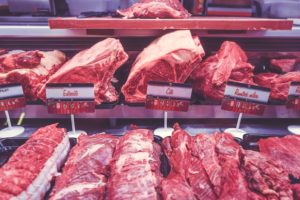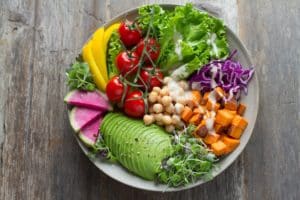Is there a way to modify our lifestyle to lower our risk of cancer?
According to the National Cancer Institute, in 2019, cancer claimed the lives of 606,880 people in the United States alone, and there was an estimated 1.76 million new cases of cancer diagnosed. Worldwide, cancer is one of the leading causes of death. In 2018, there were 18 million new cases involving cancer leading to 9.5 million deaths worldwide. It’s estimated that by 2040, there will be 27.5 million new cases a year and over 16 million deaths worldwide—mostly due to an aging population.
The most common cancers of today include the following: breast, lung, prostate, colon, rectal, melanoma of the skin, bladder, non-Hodgkin lymphoma, kidney, renal pelvis, endometrial, leukemia, pancreatic, thyroid, and liver cancer.
Cancer has touched every one of us in some way, be it a close relative, a friend, or coworker. This deadly disease has brought great emotional pain to our world. The statistics on cancer’s effect on U.S citizens are staggering. Approximately 38.4% of men and women will be diagnosed with cancer during their lifetime.
Cancer in our youth
Sadly, cancer isn’t only affecting adults; it’s been increasingly diagnosed in children and adolescents. Per the NIH, 15,270 children and adolescents ages 0 to 19 were diagnosed with cancer in 2017. Healthcare providers and researchers are working at an extreme pace to reach a solution to preventing this mortal disease that is plaguing our society. In this sad array of information, the good news is that the NIH estimated that there were 15.5 million cancer survivors in the U.S. in 2016. It’s predicted that the number of survivors is expected to increase even further to 20.3 million by 2026.
How can we increase the rate of cancer survivors? Better yet, how can we prevent the increase of cancer patients?
The connection between red meat and cancer
The American Institute for Cancer Research analyzed how consuming meat affects the risk of developing cancer. Animal foods include animal flesh and foods that are produced by animals (like eggs and dairy). So if people have eaten meat for all of history, why is an epidemic of cancer that is happening now being attributed to a food (ie. meat) that has been eat for all of history without an epidemic of cancer following it.
analyzed how consuming meat affects the risk of developing cancer. Animal foods include animal flesh and foods that are produced by animals (like eggs and dairy). So if people have eaten meat for all of history, why is an epidemic of cancer that is happening now being attributed to a food (ie. meat) that has been eat for all of history without an epidemic of cancer following it.
Well, there are a few reasons. One is that we eat a lot more meat than our ancestors. Also, animal meats are often processed before consumption by smoking and curing, which involves adding preservatives like nitrates. Our ancestors made cured meats using salt and spices and cured meat as a way to preserve it. But over that last one hundred years, food manufacturers shifted to curing with sodium nitrate and potassium nitrate (as well as salt) when they discovered that nitrates preserve better than salt but also makes the meat stay red, enhancing the appearance for a long time. These nitrates and other chemicals (which our ancestors never used) are now being used to create cured meats just for taste, appearance and for cultural reasons–obviously not for preservation reasons since we all have fridges.
If the chemicals in cured meats isn’t enough, we give our livestock medicine like antibiotics and hormones during the the growth process and that also becomes part of our food supply. We give them hormones to speed up and maximize their growth and then we give them antibiotics so that they won’t get sick when we pack them into large feed lots and trucks prior to butchering them.
And then on top of it, meat and fish are cooked at high temperatures during frying, grilling, boiling, or barbecuing. By cooking meats at high temperatures, it results in the formation of heterocyclic amines and polycyclic aromatic hydrocarbons (PAH). Astonishingly, both chemical structures are linked to the development of colorectal cancer. Red meat has high heme iron, which stimulates colorectal carcinogenesis (the process that turns normal cells into cancer cells). Heme iron stimulates the endogenous formation of carcinogenic N-nitroso compounds. When meat is burnt incompletely, polycyclic aromatic hydrocarbons are formed. These specific hydrocarbons have carcinogenic potential. In plain English, when cooking meat, cancer causing carcinogens come from fat dropping off the cooking meat contacting the flames and sticking to the surface of the food.
These methods of production and preparation can change the chemical composition of meat. The Institute for Cancer Research concluded that red meat and processed meat increases the risk of colorectal cancer, and Cantonese-style salted fish increases the risk of nasopharyngeal cancer. Another study found evidence that indicates that dairy consumption leads to a higher risk of prostate cancer. With all the scientific evidence stacking up, it’s not hard to see how eating animal products might increase the risk of cancer in some individuals.
Who would have thought that food could affect our bodies in this way?
The extra danger in processed meat
Processed meat (literally means any meat that isn’t fresh and includes meats like beef jerky, chicken nuggets, canned meats, hot dogs, sausages, and deli meats) is rich in fat, protein, and heme iron, which sparks tumorigenesis through the same mechanisms mentioned above. Since processed meat is so much higher in fat content, it leads to carcinogenesis through the synthesis of secondary bile acids as well. It is almost unfathomable just how greatly processed meat hurts our bodies and helps cancer to grow.
“The evidence on processed meat and cancer is clear-cut. The data show that no level of intake can confidently be associated with a lack of risk. Processed meats are often high in salt, which can also increase the risk of high blood pressure and cardiovascular disease,” – Professor Martin Wiseman, WCRF International’s Medical and Scientific Adviser.
Cancer is preventable!
It’s shocking to think that cancer can be preventable, isn’t it? Sure, genetics plays a role there are people who eat meat, smoke and drink alcohol all of their lives and live to 100 with barely an illness and some people are vegans their whole life and die of cancer. But those are the exceptions, not the rule. Science is finding that lifestyle is the one contributing factor that is within your control that can lead you to have a healthy life.
Scientists and health providers are realizing the only way to beat this trend is to change society’s lifestyle practices. Who would have thought that lifestyle could alter cancer’s effect? Could this be a key to stopping cancer’s destructive pathway?
“The food we eat, how active we are and how much we weigh are all things that influence our risk of cancer, and all of these factors are modifiable – there are things people can do to reduce their risk.” – Dr. Kate Allen, Executive Director, Science and Public Affairs
A plant-based diet for cancer prevention
 We spoke about many foods that increase the risk of cancer, but what foods decrease the risk for cancer or prevent it altogether? A high-fiber, plant-based diet is the solution to preventing cancer. This diet includes foods like grains, legumes, fruits, and vegetables. These plant-based foods protect against the risk of all forms of cancer caused by meat and can even protect against breast cancer. The World Cancer Research Fund (WCRF) recommends the whole, planted-based foods as a solution to prevent cancer. Maybe giving those foods we find less desirable, like vegetables and fruit, a “shot” and decrease the risk of cancer.
We spoke about many foods that increase the risk of cancer, but what foods decrease the risk for cancer or prevent it altogether? A high-fiber, plant-based diet is the solution to preventing cancer. This diet includes foods like grains, legumes, fruits, and vegetables. These plant-based foods protect against the risk of all forms of cancer caused by meat and can even protect against breast cancer. The World Cancer Research Fund (WCRF) recommends the whole, planted-based foods as a solution to prevent cancer. Maybe giving those foods we find less desirable, like vegetables and fruit, a “shot” and decrease the risk of cancer.
“Our evidence suggests the greatest risk is for people who consume no or hardly any vegetables or fruit,” – Dr. Rachel Thompson, WCRF’s Head of Research Interpretation.
The WCRF concludes that one can reduce the risk of cancer by 40% by avoiding processed meat, red meat, dairy, sugary drinks, alcohol, and by committing to regular exercise.
That means eat out less, choose whole foods to buy over processed and try to eat five to six servings of fresh fruit and vegetables in a day. One serving of fruit is one cup, which is half an apple, so it’s not as hard as you think to get five to six servings a day.
When it comes to your health, where are your priorities?
Health educators have an urgent task to inform the public about how they can make this transition in their lifestyle. It is not an easy change when it has been a familiar way of life. But it can be done and the results will be astounding. After all, it is your life and health, so take charge of your lifestyle today.


2 servings
1 slice
* The % Daily Value (DV) tells you how much a nutrient in a serving of food contributes to a daily diet. 2,000 calories a day is used for general nutrition advice.